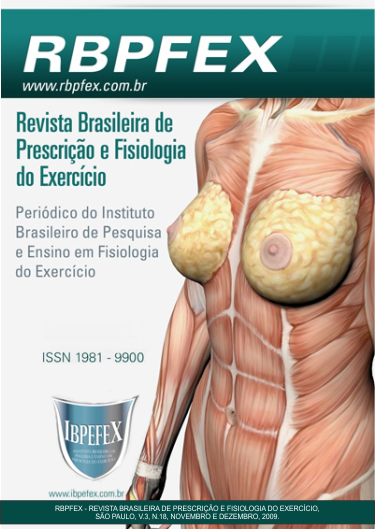University volleyball athlete’s saliva’s pH variations subjected to test in a treadmill with increase of load
Abstract
There are several ways of physical and morphological assessments. The saliva has been studied for their reaction in exercises both in quantity and in its substrates. Among components that we can study in saliva, when we are practicing exercise, we have the pHs level. Therefore this present study aims to verify if exist any variation in saliva’s pH in women's volleyball athletes subject to testing in a treadmill with increasing load. The study included nine women with mean age of approximately 19 years, with average weight of 68kg and 1,711m in height. The same women practice volleyball for approximately 10 years and today are female athletes of the volleyball ́s team at the University Lutheran of Brazil (ULBRA), campus Canoas / RS. The tests were performed in LAFIMED in the afternoon and is divided into five stages. In each stage of two minutes was an increased load of effort and the saliva was collected in the spit way in a plastic cup. Subsequently the pH was analyzed for each stage. Obtained the following average results of the group studied pH: 7.61, 7.75, 7.69, 7.64 and 7.78 in five stages. The research showed that there is a pH ́s variation of saliva when subjected to the test with increasing load, but the variation was not equal in all individuals analyzed.
References
- Almeida, P.D.V.; Gregório, A.M.T.; Machado, M.A.N.; Lima, A.A.S.; Azevedo, L.R. Saliva Composition and Functions: A Comprehensive Review. The Journal of Contemporary Dental Practice, Vol. 9. Num. 3. 2008. p. 72-80.
- Chicharro, J.L.; Calvo, F.; Alvarez, J.; Vaquero, A.F. Anaerobic threshold in children: determination from saliva analysis in field testes. European Journal of Applied Physiology. Vol. 70. 1995. p. 541-544.
- Chicharro, J.L.; Legido, J.C.; Alveres, J.; Serratosa, L.; Bandres, F.; Amella, C. Saliva electrolytes as a useful tool for anaerobic theshold determination. Kur- J. Appl Phys. Madrid. Vol. 68. 1994. p. 214-218.
- Chicharro, J.L.; Perez, M.; Vaguero, A.F.; Urena, R.; Saliva. Composition and Exercise. Sports Med. Vol. 26. Num. 1. 1998. p. 17-27.
- Humphrey, S.; e colaboradores. A review of saliva: normal composition, flow, and function. The Journal of Prosthetic Dentistry. Vol. 85. Num. 2. 2001. p. 162-169.
- Martins, K.C.; Costa, K.C.; Martins, R.P.; Lamoumier, S.; Salmen, F.E. Análise de Biomarcadores Salivares e Plasmáticos no Ciclo Ergômetro com incremento de Carga Até a Exaustão. Revista Brasileira de Medicina Desportiva. Vol. 12. Num.4. 2005.
- Powers, S.; Howley, E. Fisiologia do Exercício: teoria e aplicação ao condicionamento e ao desempenho. São Paulo: Manole: 2004.
- Santos, R.V.T.; Almeida, A.L.R.; Caperuto, E.C.; Martins Junior, E.; Rosa, C.L.F.B.P. Effects of a 30-km race upon salivary lactate correlation with blood lactate. Comparative Biochemistry and Physiology, Part B. Vol. 145. Num. 1. 2006. p. 114-117.
- Tortora, J. G. Corpo Humano: Fundamentos de Fisiologia e Anatomia. 4 ed. São Paulo: Artmed. 2004.
Authors who publish in this journal agree to the following terms:
- Authors retain the copyright and grant the journal the right of first publication, with work simultaneously licensed under the Creative Commons Attribution License BY-NC which allows the sharing of the work with acknowledgment of the authorship of the work and initial publication in this journal.
- Authors are authorized to enter into additional contracts separately for non-exclusive distribution of the version of the work published in this journal (eg, publishing in institutional repository or book chapter), with acknowledgment of authorship and initial publication in this journal.
- Authors are allowed and encouraged to post and distribute their work online (eg, in institutional repositories or on their personal page) at any point before or during the editorial process, as this can bring about productive change as well as increase impact and impact. citation of published work (See The Effect of Free Access).






